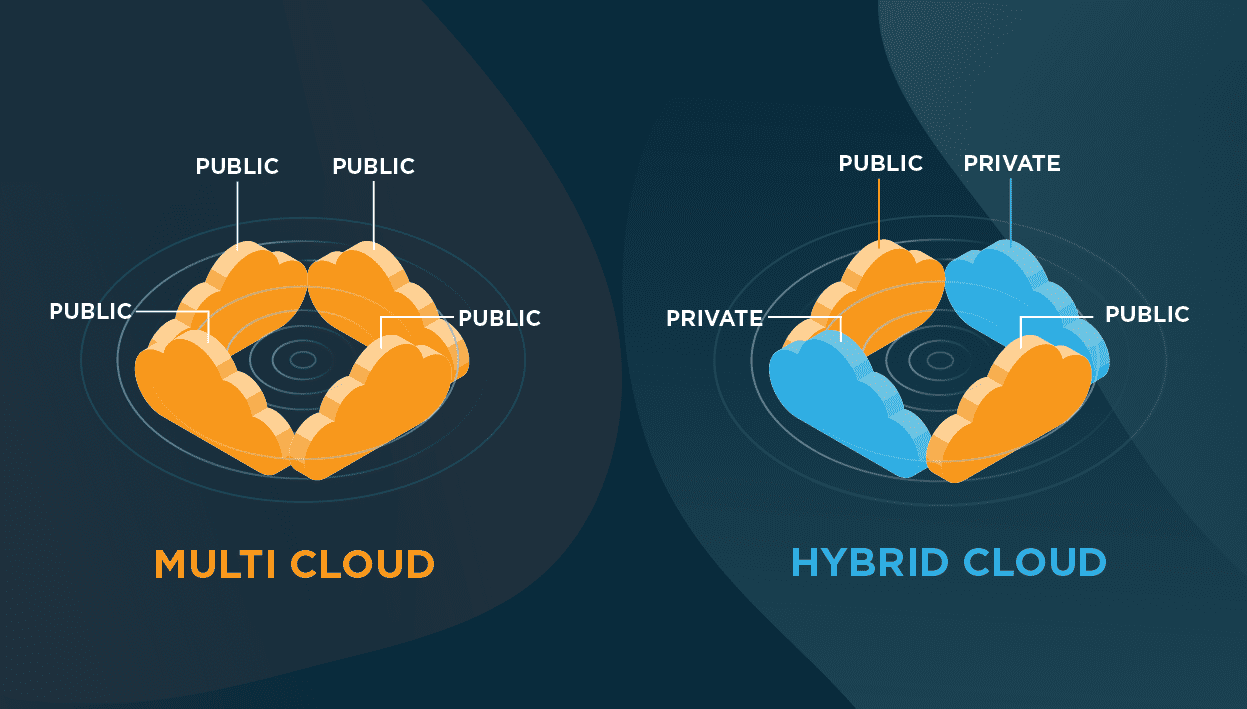Multi-Cloud Trends: The Latest Trends


Cloud computing has gained nearly universal adoption.
Today, 92 percent of organizations have a multi-cloud strategy in place or underway, and 82% of large enterprises have adopted a hybrid cloud infrastructure. On average, organizations are using 2.6 public and 2.7 private clouds.
Multi-cloud trends for 2023 will focus less on the initial adoption of multi-cloud environments but instead on the continued growth, efforts to control costs, security, and matching the right applications to cloud services.
The Continued Growth of Multi-Cloud and Hybrid Infrastructure
The adoption rates of multi-cloud and hybrid cloud strategies are expected to continue rising in the year ahead. As enterprises continue their cloud migration and digital transformation, more companies will use multi-cloud environments to distribute their workload. This fosters innovation by aligning workloads with the cloud service that is best for the use case. Other benefits include failover capabilities for better redundancy and disaster recovery, avoiding vendor lock-in, and pay-as-you-go models.
Hybrid cloud technology models can include on-premises resources, dedicated private clouds, and multiple public clouds for applications and data. This gives organizations more control over how and where their data is stored. Companies may want to keep sensitive information on on-prem servers for security or compliance reasons while taking advantage of the scalable computing capacity of the cloud.
You can see the growth happening already when you look at spending on the public cloud. Flexera’s 2022 State of the Cloud Report shows that more than a third of enterprises (37%) report annual spending on cloud computing exceeding $12 million.
The way enterprises are approaching multi-cloud environments is evolving. Many organizations already have different applications or workloads running on different clouds, but they chose clouds on an ad hoc basis rather than as part of a strategic plan. Mixing multiple services, cloud providers, and cloud environments can quickly complicate architecture design and dependencies.
As the cloud-native tech stack grows, companies will need to rethink their cloud strategy. A haphazard approach to digital transformation is a pathway to failure, as indicated by McKinsey’s report that 70% of complex, large-scale transformations fail to reach their goals due to poor planning. In the rush to add services and embrace multi-cloud, many organizations have moved quickly without the due diligence and strategic planning required to effectively create and optimize a long-term multi-cloud strategy.
Look for more enterprises to take a step back and map out their multi-cloud and hybrid cloud strategies to better align with business goals, drive innovation, and manage costs.


Read the Differences and Advantages of Hybrid Cloud and Multi-Cloud ➝
Management of Cost Control in Cloud Environments
In 2020, the work from home movement and distributed workforce fueled an acceleration in cloud infrastructure adoption. As IT leaders made more applications and data available to remote workers, multi-cloud data solutions became essential to managing the day-to-day operations.
Some 90% of industry executives said cloud computing usage was higher than expected due to the extra capacity needed. One major concern among CIOs is the increasing expense to adopt, manage, and maintain private clouds, public clouds, hybrid clouds, and multi-cloud environments for end-users. While embracing the benefits of multi-cloud infrastructure, enterprises often struggle to forecast spending accurately and fear they are overspending on cloud computing services.
Managing cloud costs requires monitoring cloud usage and provider capabilities to ensure enterprises are getting optimal usage. Just as unused SaaS platforms get trimmed from the budget, businesses will need more granular insight into their multi-cloud and hybrid cloud environments to make better business decisions.
Cloud providers offer different pricing models with fixed cost structures and additional charges depending on usage and types of services. It will take a more concentrated approach to manage these costs and fins cost savings. Multi-cloud trends in 2022 will include offloading some workloads to a less expensive public cloud and aggressive pricing conversations with cloud providers. However, we recommend caution in moving data between clouds as high egress fees can be costly and create vendor lock-in.
Matching the Right Applications and Services
A significant advantage to multi-cloud computing is the ability for IT leaders to select the cloud providers they feel provide the best environment for the applications.
As cloud providers compete for customers and roll out new capabilities, we are seeing a shift in which cloud organizations choose for different purposes. The 2022 trend to watch is blending capabilities and cost points for the right balance.
Growing Adoption of Microsoft Azure and Google Cloud
While Amazon Web Services (AWS) continues to be the market leader in cloud environments, Azure and Google Cloud have significantly increased their market share over the past year.
The 2022 State of the Cloud Report shows that Azure has caught up with AWS in public cloud adoption with 76% of enterprises running some or most of their application workloads on AWS and 77% doing the same on Azure. Google Cloud adoption rates still trail AWS and Azure with a 48% overall adoption.
Oracle Infrastructure (28%) and IBM Public Cloud (25%) grew in 2022. On average, respondents use 2.6 public and 2.7 private clouds, so these adoption rates total over 100%.
Containers for Faster Deployment
Among the fastest-growing multi-cloud trends is the use of container technologies, such as Kubernetes and Docker. Containers allow for rapid deployment and scaling across on-prem and cloud environments.
Containers are an easy way to build, package, and deploy applications. Developers use containers to package applications into portable and self-contained environments. The clean separation allows developers to focus on application dependencies and logic while operations teams focus on deploying and managing applications without worrying about details such as configurations or specific versions.
The versatility to transport workloads, data, applications, and microservices between clouds, on-premises, or at the edge is why the container market is expected to grow at a 30% rate to account for more than $4.2 billion by this year. in market spend, according to 451 Research.
Serverless Computing
Another multi-cloud trend is the continued adoption of serverless computing.
With serverless architecture, the physical hardware, virtual machine operating systems, and web server management are outsourced to the cloud service provider. Management tasks, such as capacity provisioning and patching are handled by the provider. All you have to worry about is the application code.
Serverless architecture allows developers to write code, set configuration parameters, and upload the entire package to cloud-based servers. By taking advantage of Function-as-a-Service (FaaS) inherent in serverless computing, you pay only for the resources when you use them, can scale up or down automatically, and avoid having to manage the infrastructure.
Cross-Cloud Integration
Integration between cloud environments is challenging. While containerization and cloud-native applications help mitigate integration challenges to a degree, multi-cloud trends moving forward will see better integration and more workload sharing across multi cloud environments.
As companies look to reduce costs, integration costs will be under the microscope and will influence purchases and going forward.
Multi-Cloud Security
Increasing the number of cloud providers for an organization can increase your security by providing failover options. If a primary cloud provider suffers an attack, you can still continue to operate.
While on-premises data centers and solutions typically relied on third-party tools for infrastructure security, most organizations adopting enterprise multi-cloud platforms want security tools that are built-in and native to the cloud provider. This is quickly becoming a best practice in the industry.
Over the past couple of years, we’ve seen an increased emphasis by cloud providers to up their game when it comes to security.
-
Microsoft says it spends more than $1 billion annually on cybersecurity across its platforms, including Azure, and recently announced the intention to add CyberX to its portfolio to help manage growing connections to IoT devices. Microsoft also bought Blue Talon to help simplify data privacy and governance.
-
Google folded its enterprise security company Chronicle into Google Cloud and continues to acquire other third-party security providers, such as Actifio to protect business-critical workloads.
-
VMWare bought Carbon Black in a $2.1 billion deal. It recently acquired Mesh7 to secure cloud-native applications and microservices with improved monitoring of app behavior at the API layer.
Nearly all successful cybersecurity attacks on cloud services result from customer mistakes or misconfigurations, according to a Gartner survey. As more cloud services and more cloud service providers are added, the complexity of consistently managing configurations and governance across a multi-cloud infrastructure increases.
As such, we’re seeing a rise in Intelligent Cloud Security Posture Management (CSPM) to help unify compliance and configuration management across platforms. In multi-cloud environments, there can be thousands of settings to manage. Even a few misconfigurations can lead to security problems — especially in public cloud environments.
Multi-Cloud Data Solutions for Today (and Tomorrow)
As 2022 continues to unfold, CIOs need to examine how these cloud trends will impact multi-cloud, cloud, and hybrid cloud strategies for years to come. Investments being made now will have consequences — either positive or negative — long into the future. A strategic plan for adopting multi-cloud strategies to accommodate today’s needs and plan for future growth is essential.
At Faction, we are dedicated to making complex multi-cloud environments simple and accessible so you get more value from your data. If you want to compete — and win — with data, you need a multi-cloud strategy to drive innovation and growth. Request a quote today and let us show you how we can transform your data strategy.
Watch How Faction Helped Centralize Data and Reduce Operating Costs ➝
